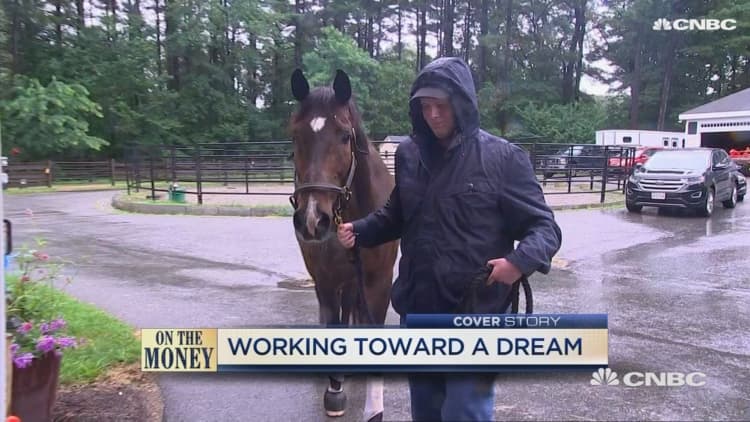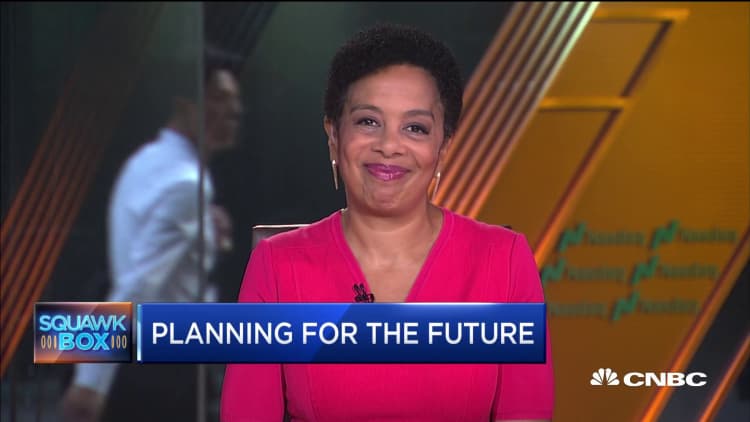Most people take being able to save money for granted.
But for people with a disability, whether developmental or physical, a previous $2,000 limit meant not being able to plan and save for a house, a car or a vacation.
"The things we all enjoy and set money aside for, to have a good life," said Robin Arter, executive director of the nonprofit Think Ability in Duncan, Oklahoma.
Accumulating more than $2,000 would have meant losing critical benefits, such as Medicaid or access to supportive services.
More from Invest in You:
Money mind hacks from bloggers can boost your finances
Retirement luxury on a Social Security budget
If you don't know much about investing start here
Thanks to ABLE accounts, also known as 529 A savings accounts, one couple bought a home, and one woman is saving for a condo.
These achievements weren't possible until 2014, when ABLE accounts were signed into law under the same tax code as 529 college savings plans. Their purpose was to allow people with disabilities to save money without losing benefits such as supplemental Social Security income or Medicaid.
The tax-advantaged savings accounts have transformed the financial lives of people with disabilities and their families.
"They haven't been allowed to dream, and we really have to prompt them," Arter said. Suddenly people are having conversations about what they want for their future. In the past, there was always a ceiling.

'Emotional barrier'
Compared with 529 college savings plans, ABLE accounts may seem as if they're not attracting a lot of users. As of the third quarter of 2019, there were more than 51,000 ABLE accounts with about $300 million in assets under management, according to ISS Market Intelligence, a mutual fund analysis company. For the same period, 14 million accounts invested $351 billion in 529 savings and prepaid plans.
One reason: Several generations of parents with disabled children have been cautioned against keeping money in their kids' names, said Chip Gerhardt, a registered lobbyist in Ohio and a federal and state ABLE advocate who worked to pass legislation.
Since 1964, people have turned to special needs trusts, if anything, to plan for their children financially. "It's hard to shift immediately to put money into an account," he said. "I think there's an emotional barrier."

Over time, data show, accounts are increasing in number and assets, said Andrea Feirstein, managing director of AKF Consulting, a municipal advisor to state-run investment plans.
In Ohio alone, about 100 new accounts have been opened each week since the program started, Gerhardt said.
When Stuart Spielman, senior vice president of advocacy at Autism Speaks, opened an account for his son with autism, he recognized it as "a product that is really designed for people like my son," he said. "It is tailored so he won't lose benefits. Until recently, there wasn't something to meet the life needs of someone with autism and other disabilities."
Choosing a program
Information about ABLE can feel overwhelming. Start with your own state, Feirstein says. Forty-two states and the District of Columbia have plans. There's no federal tax deduction for contributions, but some states offer a benefit in the form of a credit or a deduction. The annual contribution limit is based on the gift exclusion tax: $15,000 for 2020. Working account holders can contribute an additional $12,060 through payroll deductions.
Next, check whether yours is one of the 16 states with a tax break on contributions. They are Arkansas, Illinois, Iowa, Kansas, Maryland, Michigan, Mississippi, Missouri, Montana, Nebraska, Ohio, Oregon, Pennsylvania, South Carolina, Virginia and West Virginia.
Then, look at fees. The ABLE National Resource Center has a comparison tool for a side-by-side look at different plans. Once you get a sense of the account fees, check the specific state sites for more detail. Keep in mind that there are different types of fees: for maintaining the account, the actual investments and administering the state program.

Look at the states that have a Medicaid recovery policy. After an account holder dies, some states will seize unused assets from the account because of the benefits given out over the years,.
You'll also want to see if a plan offers a prepaid card or a debit card, and if the card can be used by someone's caregiver. "It's less important than what it's going to cost or what [your] state is going to do," Feirstein said. "But ease of use is something to consider."
A home of their own
Before they could save using an ABLE account, Michelle McCulloch, 41, and Donald McCulloch, 40, faced a monthly spend-down so they wouldn't go over the asset limit. Each has a developmental disability. They bought clothes, an iPad, DVDs — just to make sure they didn't hit the tripwire that would jeopardize their benefits.
Both of the McCullochs have fast food jobs, and Donald does some volunteer work. Their focus is now on saving and budgeting, not spending. Donald's mother says they fill out a budget form each week of expenses, bills and other necessities. They look at what's left over, and figure out their costs and an amount to save.
In less than two years, they had saved enough in the account to buy their house in Duncan, Oklahoma, which is convenient thanks to close shopping and restaurant options, as well as friends who live nearby. Among other goals, Donald McCulloch would like to compete in the Special Olympics in basketball, bowling, running and softball throw, a goal he can help pay for using the ABLE account.
Becoming a saver
Rosie Lawrence-Slater, 31, lives in Norwood, Ohio, a suburb of Cincinnati and also has a developmental disability. With her mother's help, she opened an ABLE account in her home state in 2017. She planned to use it for some legal expenses, but it's now her savings account.
As well as Lawrence-Slater's own contributions, family members and friends also put in money through direct transfer. Because a debit card might be tempting, Lawrence-Slater chose not to have one. She uses the account for long-term savings.
In just under two years, Lawrence-Slater has stashed a little more than $13,000, money that's earmarked for a condo. "It makes me feel really proud of myself," she said.
'It's never too early'
He's just 2 years old, but Alexander McClain already has some money stashed in an ABLE account started by his parents.
Lauren McClain, Alexander's mother, is 36 and works for a bank that offers trust services, including ABLE accounts. She opened the account as soon as he was born with Down Syndrome, a qualifying disability. About 6,000 babies with the condition are born in the U.S. each year, according to the National Down Syndrome Society.
McClain says the account indirectly benefits her older kids. "That's our goal," she said. "To make sure the older kids can make sure Alex's future is about him without worrying about the services he needs."
McClain is using as aggressive an investment strategy as the plan allows. "We are very aggressive because of his age," she said. "It's truly for his future."
A job and a future
Gerhardt is not just an advocate who worked on federal and state ABLE account legislation. He is also the dad of the first ABLE accountholder in the country: his daughter, Anne Gerhardt, 22, who has Down syndrome.
Ohio was the first state to open a program, and Gerhardt immediately opened an account. "I don't want to leave anything to chance when we're not here when it comes to taking care of our daughter," he said.
Anne, who works at a Kroger grocery, plans to use a debit card for clothes, food, rent and Uber rides once she moves out of her parents' house. "Having a STABLE account [the Ohio plan] lets me use my own money for things that I need," she said.
"It's the most significant professional achievement I'll ever have," Gerhardt said. "I can't imagine anything bigger than this."

SIGN UP: Money 101 is an 8-week learning course to financial freedom, delivered weekly to your inbox.
CHECK OUT: Here's what kind of mortgage rate you'll get depending on your credit score via Grow with Acorns+CNBC.
Disclosure: NBCUniversal and Comcast Ventures are investors in Acorns.





